A winter wonderland at Oirase Keiryu!

Oirase Keiryu (奥入瀬渓流 Oirase keiryū) is a 14km picturesque mountain stream located in the northern prefecture of Aomori, and is probably my favourite place in Tohoku. It is always such a relaxing hike with beautiful scenery. When I found out that Oirase Keiryu could also be visited in winter relatively easily, I knew I had to include it in my itinerary!
Although Oirase Keiryu is best enjoyed with its golden yellow foliage in autumn, or verdant greenery in the early summer season, winter is beautiful yet underappreciated. As the northernmost prefecture on mainland Japan, Aomori experiences abundant snowfall in winter – one of the highest in Japan.
At the Towada-Hakkoda area, which includes Oirase Keiryu, Mount Hakkoda (八甲田山 Hakkōdasan) and Lake Towada (十和田湖 Towadako), winter translates to frozen waterfalls, snow-covered trees (even snow monsters if the conditions are right), and fluffy white scenery all over. The best part? Definitely the outdoor onsens overlooking the winter scenery.
Hailing from a warm and humid tropical country, experiencing snow scenery, especially those formed by nature, is something I look forward to when on vacation. There are not many places that still have snow in March, but luckily for me, Oirase Keiryu is one of the places that do.

Winter scenery at Oirase Keiryu. (Image credit: JR East / Carissa Loh)
From April to November, you can take a day trip by bus from Aomori Station (青森駅) or Hachinohe Station (八戸駅) to explore Oirase Keiryu. But in winter, when public transport hardly runs, the best way to experience the unique snow scenery would be by staying overnight at the only hotel along the stream, the Hoshino Resort Oirase Keiryu Hotel (星野リゾート 奥入瀬渓流ホテル). Run by the world-class Hoshino Resorts chain, this cozy and spacious hotel offers many services and activities to give you a special and memorable winter experience.
In early March 2020, wanting to experience this magical winter scenery at Oirase Keiryu, I stayed at Oirase Keiryu Hotel for a night. (This is not a sponsored post. I thoroughly enjoyed my stay here, and thought it would be good to share. I had previously stayed here in 2016 when I first went hiking in Oirase Keiryu, but only recently found out the winter specials.)
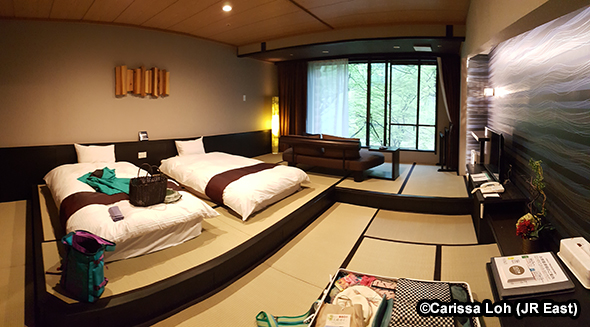
Room at Oirase Keiryu Hotel. (Image credit: JR East / Carissa Loh)
The hotel provides free shuttle bus services to and from JR Aomori Station (~2 hours) and JR Hachinohe Station (~1 hour), which would usually cost ¥2,000–¥3,000 per head per way by public buses. They also conducts free tours for staying guests to experience the winter sights which you would not be able to go to on your own.
Pick-up and drop-off services and activities require prior reservations, which I easily made through a form on the hotel website. Pick-up from JR Hachinohe Station was at 13:50, and I arrived at the hotel at around 15:00, just in time for check-in. After check-in, I promptly went for a quick dip in the wonderful outdoor onsen, and took a short nap before dinner. The rooms are very spacious, with some overlooking the stream!
Relaxing at the hotel

Outdoor onsen in the evening. (Image credit: Oirase Keiryu Hotel)
Only during winter, the hotel provides free tours for staying guests to see frozen waterfalls and snow-covered streams. These are amazing natural sights that I could never imagine getting up close to if not by some special arrangement. One of the highlights within the hotel is its massive open-air outdoor bath (露天風呂 rotenburo) overlooking the stream. The water feature behind the bath also freezes. Onsens are one of my favorite things about Japan, especially outdoor ones in the middle of nature. It is such a wonderful feeling soaking in the warm waters, staring at the expansive white scenery as snow falls lightly over your head… For obvious reasons cameras are prohibited in the onsen area.
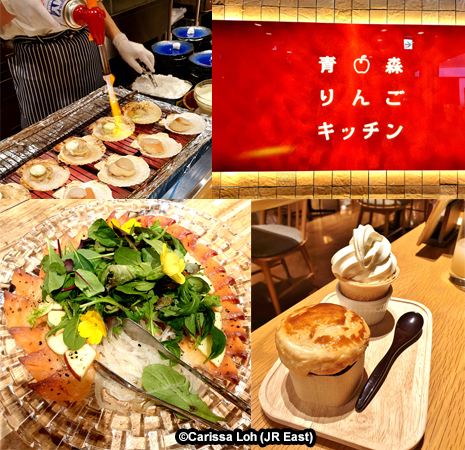
Dinner at Aomori Ringo Kitchen. (Image credit: JR East / Carissa Loh)
Dinner was a buffet at the hotel restaurant 「Aomori Ringo Kitchen」. Ringo means apple in Japanese, and did you know? Aomori produces the most apples in Japan! The buffet dinner featured a lot of dishes infused with apples, such as prosciutto with apple jelly, marinated salmon with apple puree, their signature freshly-baked apple pie with milky ice cream and more. There are also other local specialties like senbei-jiru (せんべい汁 rice cracker soup), grilled scallops and kelp ramen. For apple lovers, there are many different types of apple juices and fresh apples available as well.
Frozen Waterfall Illumination
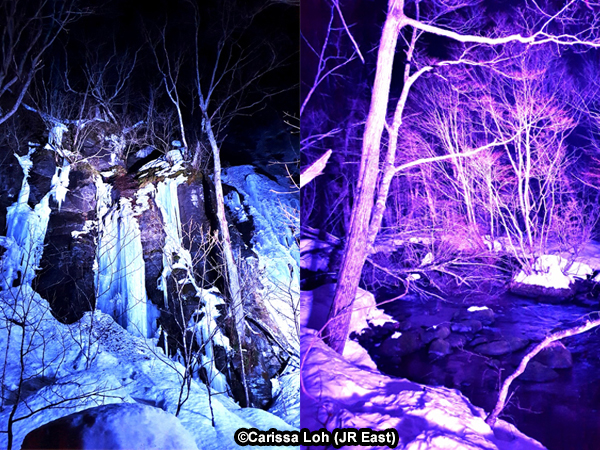
Frozen Waterfall Illumination Tour. (Image credit: JR East / Carissa Loh)
After dinner, I piled on some warm winter wear before heading off to join the Frozen Waterfall Illumination Tour. This is something you cannot experience unless you stay at the hotel. The tour brings you by mini bus to two places: Makadoiwa (馬門岩) and Midare no Nagare (三乱の流れ). In order to minimise impact to the environment, the lights are not installed by the waterfall or stream, but are manually transported on top of a van every session. There are about 4–8 sessions a night for staying guests, and the lights are set up each and every time. Only soft and calming colors like blue and purple are used for the lighting, so as to minimise disturbance to wildlife.
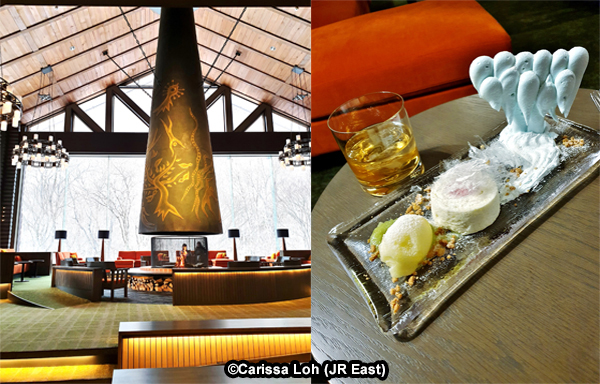
Frozen Waterfall Dessert. (Image credit: JR East / Carissa Loh)
After getting back, I warmed myself up at the lounge, which has a real fireplace with wood! And being a dessert lover, I just had to try the Frozen Waterfall Dessert, which I ordered along with some apple wine. The dessert was a mixture of tart apple sorbet, berry mousse cake garnished with nuts and sugar that looked like plastic flakes but quickly melted in your mouth, and a frozen waterfall made out of sugar frosting. Afterwards, it was time for one last onsen soak before heading to bed.
Winter Scenery
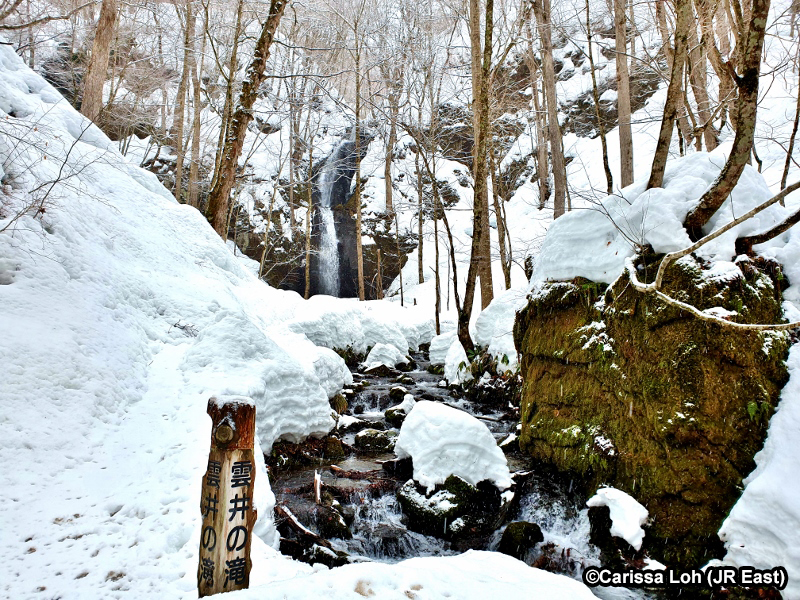
Kumoi no Taki Waterfall in winter. (Image credit: JR East / Carissa Loh)
The following morning, I took an early soak at the onsen, and went for my second tour at 07:00, the Winter Scenery Tour. For this tour, there are about nine sessions a day in the morning and afternoon, only for staying guests. Winter is when the Oirase Keiryu’s water is the clearest, and is also the only time you can see frozen waterfalls, as well as animal footprints in the snow. The guides also give an informative slideshow on the various wildlife that roam the area. Although we did not get to see them, there are deer, birds, rabbits and more.
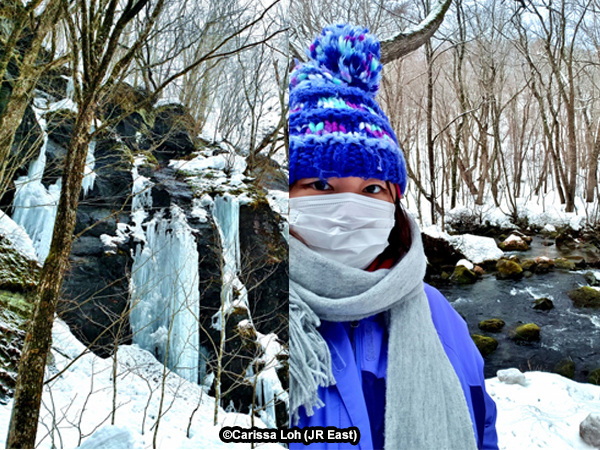
Winter Scenery at Oirase Keiryu. (Image credit: JR East / Carissa Loh)
The tour brought us to three spots along the stream: Midare no Nagare (三乱の流れ), Makadoiwa (馬門岩) and Kumoi no Taki Waterfall (雲井の滝). Two of these were the same as the previous night, and it was interesting to see the contrasting views of nighttime and in daylight. Despite the lack of snow, the outside temperature was still very cold, around -2ºC. Don’t forget to keep warm!
 How about making a gourd lamp or some forest jewelry? (Image credit: JR East / Carissa Loh)
How about making a gourd lamp or some forest jewelry? (Image credit: JR East / Carissa Loh)
Other than the scenery tours, for a fee, you can also partake in workshops like gourd lamp-making and forest jewelry-making. There are also other paid activities like guided snowshoe hikes and bus services to the nearby Mount Hakkoda for skiing.

Oirase Keiryu in winter. (Image credit: Oirase Keiryu Hotel)
The tour guides mentioned that mid-late February is usually the best time to visit, as snow would have accumulated and the weather stabilised. Due to the unusually warm winter this year, there was not much snowfall. These are some photos on how the scenery would look like with more snowfall! Wouldn’t you like to visit someday?
Oirase Keiryu is a beautiful place which is best enjoyed slowly. Other than winter, the green season, when you can go hiking and explore the entire stretch on foot, is especially scenic. Check out my other article on hiking Oirase Keiryu in autumn and summer!
Header image credit: Oirase Keiryu Hotel




